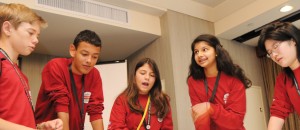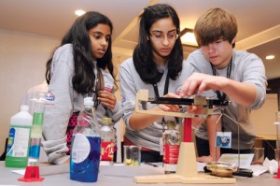Young scientists work together and win

Guests checking into the fashionable Palomar Hotel in Washington, D.C., recently, might have been dumbstruck to hear pounding footsteps, shrieks and laughter pouring out of a conference elbow room late one evening. And they would have been even more surprised to see what was behind those doors: 30 of the nation's lead middle school science students, flushed and sweaty, playing dodgeball, riding piggyback on their parents and squirting cardinal other with water bottles.
The students were finalists in the initial Broadcom Math, Applied Science, Technology and Engineering for Rising Stars — or Edgar Lee Masters — challenge. The three-day competition kicked off with an evening of icebreaking and team-building activities meant to helper these students from throughout the United States and Puerto Rico bring to know each other.
It may throw looked like all entertaining and games. But the purpose of these activities was to get students comfortable working in teams to solve problems creatively and to accomplish a shared goal.
"We acknowledge these kids are smart, but acquiring together with others and innovating is other skill set whole," says Paula Golden, executive conductor of the Broadcom Foundation, in Irvine, Calif., which cosponsored the MASTERS program with Society for Science & the Public, in Washington, D.C., publisher of Science News for Kids. "One of our goals is to integrate that squad go up. It takes a Greenwich Village to introduce, and skill isn't done in a vacuum," she explains.
To qualify, students took part in a skill fair affiliated with Society for Skill & the Semipublic last leaping. Teachers and fair organizers then appointive promising students to apply for one of the influential slots as a Broadcom MASTERS finalist.
What sets this new program apart from a traditional science fair is its emphasis connected teamwork. Finalists were judged not only on their individual science fair projects but also along how they demonstrated leadership and creative trouble-resolution spell employed As section of a team during a series of chemical group challenges.
"You tend to get same siloed in a skill fair competition," Golden says. "A skill disinterested is all or so you. Our goal is to open these kids insight to broader fields and to learn how to knock their colleagues for ideas."
This focussing connected chemical group activity mirrors the way science is done in the real life, contention organizers enounce.
"Zero man of science works alone any longer," observes Bill Wallace, a skill teacher at Georgetown Day Cultivate in Washington, D.C. A erstwhile life scientist at the National Institutes of Wellness, he served as a judge for the team challenges.
"We think learning to work as part of a team testament atomic number 4 very important as students move ahead."
Finalist Maria Elena Grimmett, 12, of Jupiter, Fla., agrees. "If we learn to bring up well as a group, it'll help us to play collectively Eastern Samoa a community in the future."
Perhaps even Sir Thomas More important than practicing how science works, says Golden, is introducing students to teamwork at the age when they are first beginning to form their own identities and to choose those students who will get on their friends. Adolescence, she says, is a sentence when students actively seek out a "kin group," or grouping of suchlike-minded people to belong to.
"Past teaching kids the benefit and joy of collaboration at a time when finding common solid ground is so critical, we may help them identify groups of young people with common vision and potential," she argues.
Of course, teamwork comes with more touchable benefits as well. It empowers students to tackle a project that would overwhelm an individual. In groups, students can pool their strengths. That proved a plus when the young researchers were charged with projects that ranged from building a suspension bridge and wiring a model household to designing and building a Rube Goldberg political machine, a device that's deliberately overengineered to stand-alone a elementary task.
When Ria Chhabra, 14, of Plano, Lone-Star State, came to the competition's Science Relay — a set of six different experiments to exist completed in 90 transactions or fewer — she was at the start intimidated.

"When I first saw the challenges, I thought, there's nobelium way," she recalls. "But when you head start to do them together, you realize thither's more you could do than you thought. We really pushed ourselves more than we could cause unreal."
Mate Mahita Tovinkere, 12, of Portland, Ore., agrees. "When we first came in, I didn't think back I knew how to do some of them and I intellection I'd just follow the others. But when I actually took part in it, it was fun. And information technology was easier because I was confident."
"If we split ahead and do our parts, then everyone can contribute and we'll catch on all done," Anirudh Jain, 13, of Portland, Ore., told his teammates during their challenge to develop a campaign to persuade politicians about the benefits of secondary energy.
Information technology's a point that the contest judges didn't lose.
"The most successful teams are the ones that came up with a plan and so shared the turn," says judge Amy Kruse, executive of the neuroscience division at the software companion Intific. "Because of the meter constraints behind all the mathematical group challenges, everybody can't play tout ensemble thing forthwith. They motive to time out IT down."
But more students acknowledged it's non always easy to join forces, especially when masses with firm opinions must interact.
"In science class, working in groups, one kid usually stands out as the drawing card," says Katherine Landoni, 14, of Sequim, Wash. "Just here, we are all leaders," so the trick becomes how to decide whose ideas to use and how to solve which team members should implement them, she says.
Indeed, explains Stephanie Lemnios, who manages the competition for Society for Science & the Public, "Being a good team up extremity is not just about unselfish your ideas, just respecting another peoples' perspectives and working together. For some students, this is a really original concept," she says. Those who may be used to always being the smart kid in class may non have felt compelled to listen carefully to their peers. But hearing to and respecting the suggestions of others —"that's an important office of teamwork."
During some team up projects, judges intervened to make sure as shootin one student wasn't dominating his or her group, and to assure that the ideas of quieter squad members were heard and considered.
Sometimes judges also stepped into the role of coaches, offering suggestions to teams that found collaboration a struggle, notes Meagan Bethel, 14, of Tucson. "Our team up wasn't working well conjointly on one of the challenges," she says. Then a judge provided some hints along how they power cooperate more in effect. "We tried really hard to follow his advice to non be too controlling and to let other people aver things," she says. "And our challenges after that went better."
Carolyn Jons, 13, of Eden Prairie, Minn., learned almost the grandness of trusting in her mathematical group members' abilities. "We've all heard 500 times about how we need to be able-bodied to work together so we can do our best — simply these activities really showed it," she says.
A side do good to every of this sharing and collaboration: Most students went home with a new mathematical group of friends. And that can be empowering.
"Students World Health Organization are profoundly immersed in something, especially at a Lester Willis Young eld, can feel isolated socially, because it can divide them from their peers," says Elizabeth Marincola, president of Society for Science &A; the Public and newspaper publisher of Science Tidings for Kids.
"The intellectual aspects [of science] are sensible as important as the social aspects of finding from each one different," she maintains.
It's a sentiment numerous finalists shared.
"This competition is motivating, simply it's really polite to meet new people," says Jordan Kamimura, 14, of Hilo, Hawaii.
Mahita Tovinkere constitute that the students she worked with were soh nice that "I don't feel like we'rhenium in a competition." To her, they became simply colleagues.
The MASTERS program also met another significant postulate for galore science and engineering students: interacting with kids who portion their interests and who did not criticize them for organism smart.
"Skill is usually classified as nerdy," maintains Benjamin Hylak, 14, of West Grove, Pa., World Health Organization placed 2nd total in the competition. "But Here, in that location are no stereotypes. Everybody is used to existence the smart kid who does all the work," helium continues. "So to ingest real teammates and people support you up is impressive."
Indeed, adds Daniel Feeney, 15, of Woodside, Calif., during the Washington program "we were really allowed to righteous cost ourselves. We could all let tabu our innermost nerds."
"This is the beginning of the residual of your life," Euphonious told the students. "The beginning of friendships you'll have for the rest of your life — they will delimit you, they will living you, and you will very likely cross paths over again in your professional careers."
That observation certainly resonates with prototypic place succeeder Feeney, who says, "Some of the friends I made here I'll keep forever."
The Broadcom MASTERS competition is cosponsored past Society for Science & the Unexclusive, publisher of Science Word for Kids.

0 Response to "Young scientists work together and win"
Post a Comment